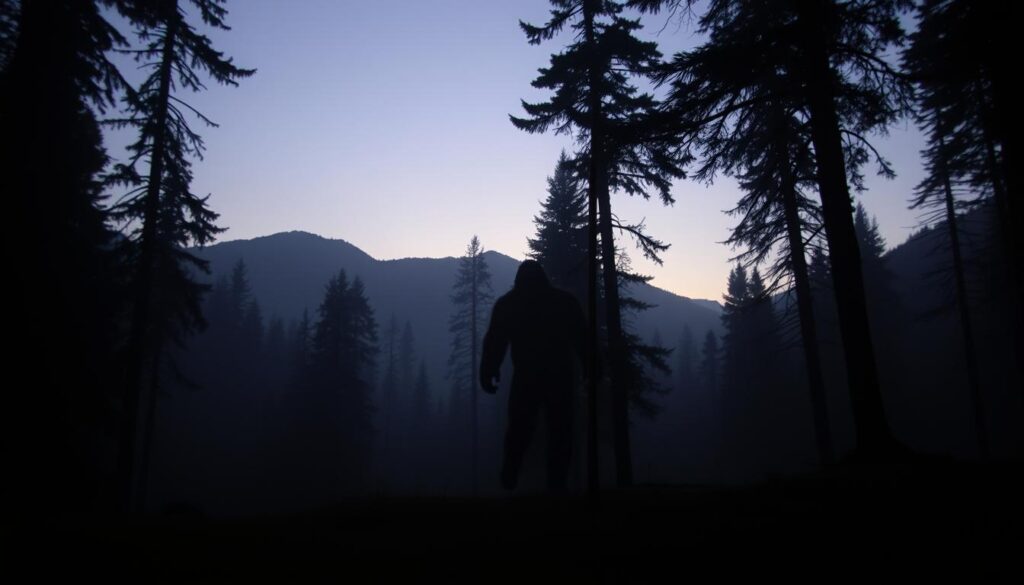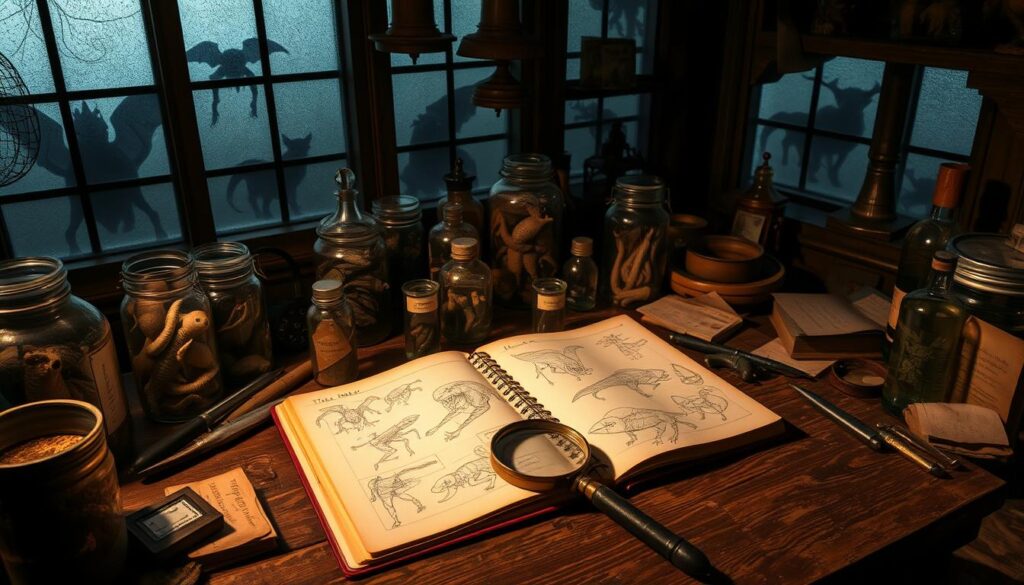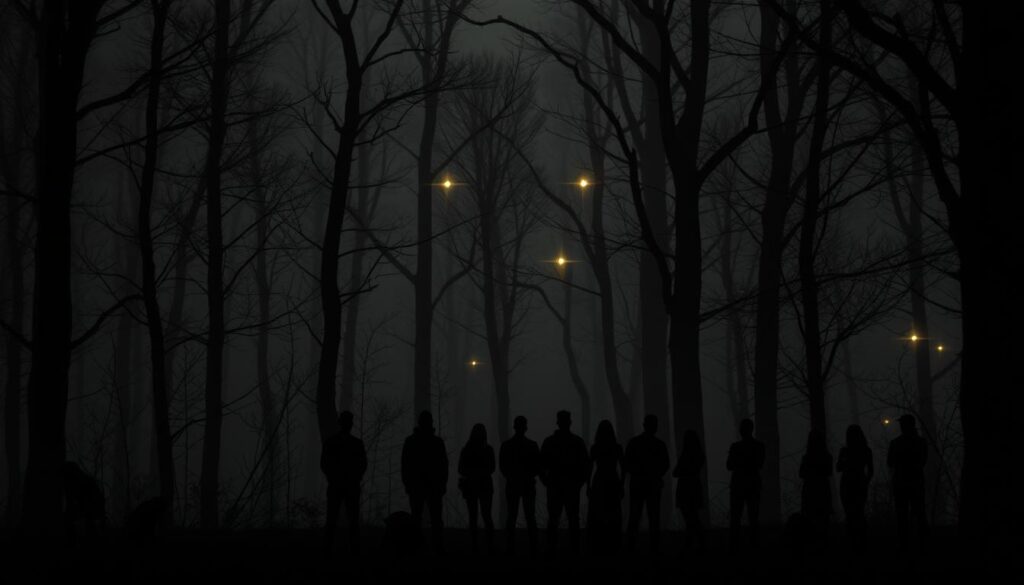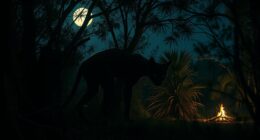Have you ever ventured into the woods, feeling a shiver down your spine as you imagine the unseen forces lurking just beyond your sight? The allure of cryptid sightings often pulls at the very fabric of our imagination, inviting us to ponder what might dwell in the shadows of our everyday reality. Tales passed down through generations weave a tapestry of mysterious creatures that embody not just fear, but an unquenchable curiosity about the unknown. From the towering Tennessee Wildman to the elusive Loch Ness Monster, the world of enigmatic beings offers a glimpse into our deepest fears and desires. It’s a world where folklore meets reality, and every rustle in the bushes could be a call from these hidden beings, reminding us that there is still much more to discover. Join me as we dive into the fascinating realm of cryptozoology, where the unknown beckons and the stories of odd sightings come alive.
Key Takeaways
- The world of cryptids captivates the imagination with reports of mysterious encounters.
- Historical tales, such as those of the Tennessee Wildman, date back to the early 1800s.
- Regions like Tennessee, with its extensive cave systems and diverse landscapes, provide ideal habitats for elusive creatures.
- Folklore plays a crucial role in shaping our understanding of cryptids and their cultural significance.
- Events and stories surrounding cryptids inspire communities and promote curiosity about the unknown.
A Timeless Fascination with Legendary Creatures
The enduring fascination with legendary creatures is a captivating aspect of human culture that continues to thrive today. From fire-breathing dragons to elusive beings like Sasquatch, these figures not only stir our imagination but also reflect deeper psychological and societal themes. This cultural significance highlights our universal curiosity and innate fear of the unknown.
In places like Maryland, folklore abounds with tales of mysterious entities such as the Snallygaster and Goatman. Reports of the Snallygaster date back to the 1700s, with a surge of sightings noted in 1909, even attracting the attention of then-President Theodore Roosevelt. Meanwhile, the Goatman legend, steeped in local woodlands, raises questions about strange occurrences and disappearances, embodying the fears ingrained in the community.
Football fans might recognize Chessie—a creature resembling the Loch Ness Monster, spotted in the Chesapeake Bay since 1936. Such reports capture the public’s attention, merging fears with a touch of wonder. Similar sentiments echo in Texas, where the infamous Chupacabra and Lake Worth Monster stir both excitement and skepticism among locals and visitors alike.
Scholars and enthusiasts alike delve into this realm through the lens of cryptozoology. By studying these fantastical beings, they unearth insights about our cultural narratives and anxieties, transforming folklore into a fascinating exploration of human nature. What lies beyond the surface of these legends often reveals more about us than the creatures themselves.

| Legendary Creature | Location | Initial Sightings | Significance |
|---|---|---|---|
| Snallygaster | Maryland | 1700s (Spike in 1909) | Reflects local anxieties and curiosity |
| Goatman | Prince George’s County, Maryland | Historical | Embodies fears of the unknown |
| Chessie | Chesapeake Bay | 1936 | Links to other cryptid sightings, evokes wonder |
| Chupacabra | Texas | 2007 | Cultural phenomenon raising skepticism |
| Lake Worth Monster | Fort Worth, Texas | 1969 | Community folklore and local festivities |
Understanding Cryptozoology
Understanding cryptozoology involves the study of unverified animals and the fascination surrounding them. This field blends rigorous research with a sense of adventure, leading enthusiasts to explore reports of mysterious creatures that elude scientific confirmation. Cryptozoologists delve into various realms, analyzing physical evidence, eye-witness accounts, and folklore from different cultures.
Over the years, numerous mysterious creatures have drawn attention, such as Bigfoot, the Loch Ness Monster, and the Chupacabra. These entities often transition from myth to reality through relentless investigation. For example, the giant squid moved from the realm of cryptids to being scientifically recognized, demonstrating that understanding cryptozoology can yield surprising developments.
One key aspect of this discipline is examining how scientific methods can intersect with folklore. Similar to archaeology, cryptozoology utilizes evidence to understand narratives about unverified animals. The interdisciplinary nature of this study breathes life into urban legends, as many cryptids become integral parts of local culture.

Through the convergence of stories and scientific inquiry, the allure of the unknown continuously captivates the human imagination, inviting you to join in uncovering the secrets of the natural world.
Tracing the Roots of Cryptozoology: From Ancient Tales to Modern Explorations
The roots of cryptozoology delve deep into ancient tales and folklore, where legends of extraordinary creatures have captivated human imagination for centuries. Early explorers recounted encounters with beasts that seem to blend myth and reality. These accounts not only entertained audiences but laid the groundwork for contemporary interest in cryptids.
As we transition into the mid-20th century, a notable increase in species discovery spurred enthusiasm for cryptozoology. The notable rediscovery of the coelacanth in 1938, a fish thought to have vanished 65 million years ago, significantly boosted the movement’s credibility. This remarkable event demonstrated that beings once deemed mythical could exist, granting hope to enthusiasts searching for the truth behind reported sightings.
Modern explorations have transformed the pursuit of cryptids, thanks to advancements in technology. Techniques such as DNA analysis and environmental DNA (eDNA) testing have emerged, offering new methodologies in the quest for these elusive creatures. For instance, water samples collected from Loch Ness aimed to unveil traces of genetic material, hinted at the potential existence of Nessie.
While critics from the scientific community often dismiss cryptozoology for its reliance on anecdotal evidence, participation in actual discoveries has not been entirely absent. Researchers regularly employ camera traps and thermal imaging to seek out cryptids like Bigfoot and the Mothman. Although definitive evidence remains elusive, these tools assist in documenting rare species in their natural habitats, bridging the gap between ancient lore and modern scientific inquiry.
| Aspect | Details |
|---|---|
| Historical Foundation | Ancient tales of mythical beasts paved the way for cryptozoology. |
| Significant Discovery | The coelacanth rediscovery proved that seemingly extinct creatures can exist. |
| Technological Advances | DNA analysis and eDNA testing have modernized investigations. |
| Ongoing Research | Camera traps are utilized in searching for Bigfoot and other cryptids. |
| Scientific Criticism | Relies heavily on anecdotal evidence, leading to skepticism. |
As the roots of cryptozoology continue to intertwine with modern explorations, the quest for understanding these legendary creatures remains an enchanting intersection of myth, science, and discovery.

Whispers of the Past: Early Accounts and Folklore
The tapestry of folklore weaves together numerous narratives about legendary creatures, providing a glimpse into the beliefs and fears of ancient societies. Early accounts of such beings often emerge from cultural mythologies, blending the boundaries between reality and imagination.
For example, the Chupacabra, first reported in Puerto Rico during the mid-1990s, illustrates how modern tales can resonate through the ages. Witnesses describe it as a dog-sized creature with glowing red eyes, adding a sense of fearful wonder to contemporary lore.
In contrast, skinwalkers, known in Navajo (Diné) folklore, bring a darker narrative to light. These malevolent figures are said to wield dark magic, achieving transformation through horrific acts. Such stories serve to warn and educate within the culture.
The mythical Wendigo from First Nation Algonquin-speaking peoples further illustrates this fascination. Described as a towering figure with a vicious appetite, it embodies themes of cannibalism and corruption, deeply ingrained in the oral traditions of its region.
Historical documents referencing Sasquatch, or Bigfoot, reflect admiration and trepidation. Said to reach heights of 7 to 8 feet, this creature draws followers through its intriguing presence in both ancient lore and modern cryptid sightings. Despite substantial interest and blurry evidence, its existence remains elusive.

Through varied accounts, the Ahool offers insight into Indonesian mythology. First reported by Dutch scientist Ernest Bartels in the 1920s, it is depicted as a massive bat-like creature, its legend rich with the essence of folklore passed through generations.
As you explore these enriching narratives, remember that each city, culture, and community offers its own interpretation of legendary creatures. This lore not only entertains but also preserves the collective memory of a society’s fears and aspirations.
| Legendary Creature | Origin | Description | Notable Characteristics |
|---|---|---|---|
| Chupacabra | Puerto Rico | Dog-sized reptilian or hairless creature | Large fangs, glowing red eyes |
| Skinwalker | Navajo Folklore | Malevolent witch with shape-shifting abilities | Dark magic, nefarious purposes |
| Wendigo | Algonquin Folklore | Cannibalistic figure, up to 15 feet tall | Malice, corruption |
| Sasquatch | North American Folklore | Ape-like creature, 7 to 8 feet tall | Pungent odor, elusive nature |
| Ahool | Indonesian Folklore | Massive bat-like creature with human-like face | Wingspan of 12 feet |
Mythical Beings Across Cultures
Exploring mythical beings reveals striking parallels across global folklore. From the elusive Yeti in the Himalayas to the infamous Chupacabra in Latin America, these tales connect communities through shared mysteries and fears. While certain characteristics may differ, the essence of these legends reflects humanity’s enduring fascination with the unknown.
The legend of the Loch Ness Monster dates back centuries, with the earliest known account appearing in the 6th century. This creature not only captivates enthusiasts but also highlights cultural comparisons within the realm of mythical beings. Cryptids like the Swamp Ape in Florida and the sasquatch in Oregon illustrate how different regions have birthed unique yet comparable legends.

In the UK, mythical beings abound, including the Barghest and the will-o-the-wisp. These creatures contribute to a rich tapestry of stories deeply embedded in local folklore, drawing parallels with cryptids worldwide. Each story carries with it cultural values and societal fears, demonstrating that while the beings themselves may vary, the core themes resonate universally.
Interestingly, the discourse surrounding these creatures raises questions about the nature of belief and skepticism. Some view mythical beings as purely fictitious, crafted from the imaginations of cultures trying to explain the unexplained. Others argue that folklore may hold hidden truths about the past, suggesting that some of these figures could be grounded in real encounters with unknown species.
| Mythical Being | Location | Origin |
|---|---|---|
| Yeti | Himalayas | Centuries of folklore |
| Loch Ness Monster | Scotland | Known since the 6th century |
| Chupacabra | Puerto Rico | Gained attention in the 1990s |
| Swamp Ape | Florida | Regional sightings |
| Sasquatch | North America | A long-standing myth |
With a broad spectrum of mythical beings, each culture intertwines its narratives with local histories, creating a fascinating landscape of folklore. The study of these legends offers valuable insights into our collective psyche and challenges us to reconsider the boundary between reality and myth.
The Coining of a Term: The Modern Emergence of Cryptozoology
The fascinating field of cryptozoology officially emerged as a discipline in 1955, initiating a journey marked by rigorous exploration and adventurous inquiry. The term itself, meaning “the study of hidden animals,” was coined by Bernard Heuvelmans, a visionary Belgian zoologist who sought clarity in the study of mysterious creatures. Heuvelmans’ work laid the groundwork for comprehending how folklore and biological data intertwine, influencing the modern emergence of this captivating science.
Long before Heuvelmans took the stage, ancient scholars like Pliny the Elder documented extraordinary animals in his Naturalis Historia around AD 77. Fast forward to the 16th century, and Conrad Gesner, recognized as the founder of modern zoology, compiled a comprehensive five-volume Historiae animalium from 1551 to 1558. Their contributions highlight an enduring curiosity about hidden creatures, which continues to this day.
As the centuries unfolded, lesser-known explorers also documented encounters with cryptids. For instance, David Thompson recorded sightings of sasquatch and its tracks in 1811, establishing connections with Indigenous narratives. Later, Anthonie Cornelis Oudemans studied accounts of “The Great Sea Serpent” in 1892, enriching the field’s historical tapestry.
In 1995, Heuvelmans’ book, On the Track of Unknown Animals, became a bestseller, amplifying interest in cryptozoology and affirming its relevance within the scientific community. The term “cryptid” itself surfaced as recently as 1983, coined by John E. Wall, which adds layers to the ever-evolving language of this field.
Today, the study of cryptozoology thrives on an interdisciplinary approach, weaving together threads from physical anthropology, mythology, archaeology, and more. This expansive framework allows enthusiasts and researchers to dissect sightings and testimonies of elusive beings, urging a thoughtful analysis of what constitutes a cryptid. This vibrant journey into the unknown not only explores remarkable creatures but strengthens the bond of shared human curiosity throughout history.

| Key Figure | Contribution | Year |
|---|---|---|
| Bernard Heuvelmans | Coined the term “cryptozoology” | 1955 |
| Pliny the Elder | Documented extraordinary animals | AD 77 |
| Conrad Gesner | Published Historiae animalium | 1551-1558 |
| David Thompson | Documented sasquatch footprints | 1811 |
| Anthonie Cornelis Oudemans | Studied “The Great Sea Serpent” | 1892 |
Face-to-Face with the Unknown: Exploring Iconic Cryptids
The world of iconic cryptids offers a glimpse into the unknown, captivating the curiosity of many through famous sightings and intriguing folklore. You may have heard of legendary creatures like the Chupacabra, or witnessed the fascinating stories surrounding the Loch Ness Monster. These beings inspire endless exploration and have sparked both excitement and skepticism among enthusiasts and researchers.
Take the Snallygaster, for example. Mentioned in the Montgomery County Sentinel in December 1932, residents of Washington and surrounding areas reported numerous sightings within just a couple of weeks. Such events fuel local lore, emphasizing the thrill of encountering these enigmatic beings.
Another iconic figure is the Jersey Devil, first spotted by woodsman Vance Larner in 1790 in New Jersey. Subsequent sightings extended into Delaware in January 1909, capturing the imagination of many. Each encounter, with its own twist of history, reinforces the blend of fact and rumor that surrounds these cryptids.
The Grand Canyon wild man, or Mogollon Monster, adds to the intrigue. In a 1903 article, witnesses described a creature resembling a long-haired man with claws. Such accounts showcase how iconic cryptids can inhabit the edges of our understanding, compelling you to question reality.
A table below highlights several notable iconic cryptids and their respective famous sightings:
| Cryptid | Location | Famous Sightings | Year |
|---|---|---|---|
| Snallygaster | Montgomery County, MD | Multiple sightings | 1932 |
| Jersey Devil | New Jersey | Vance Larner sighting | 1790 |
| Mogollon Monster | Grand Canyon | I.W. Stevens’ description | 1903 |
| Cady the Sea Serpent | Aberdeen, WA | 1,300-pound creature | 1936 |
![]()
Each of these encounters demonstrates the allure of exploration surrounding iconic cryptids. As communities engage with these legends, the narratives evolve, making them not only subjects of interest but also vital parts of local cultures. Whether seen in the wild or glimpsed through the lens of modern technology, the thrill of the hunt for these mysterious beings continues to challenge our understanding of the world.
Bigfoot: A Haunting Presence in the Wilds
Bigfoot, often synonymous with legendary creatures in North America, continues to capture the imaginations of many. Many accounts span from ancient Indigenous folklore to modern sightings in places like the Berkshires. With notable reports such as those in 1983 on October Mountain in Lee and another from 1879 in South Williamstown, the conversation surrounding this elusive creature remains vibrant.
Echoes of Legends
The Sasquatch holds a significant place in American culture. The whispers of its existence echo through generations, marked by consistent, intriguing sightings that set the stage for substantial folklore. This fascination spans various groups and ideologies, including unique perspectives brought by queer communities and far-right ideologues. The diverse narratives enrich the ongoing discussion about Bigfoot and its place in our collective mythology.
The Patterson-Gimlin Film: Fact or Fiction?
One of the most critical pieces of evidence in the pursuit of understanding Bigfoot is the Patterson-Gimlin Film, filmed in 1967. This grainy footage has kept skeptics and believers engaged for decades. Its authenticity has been hotly debated, representing perhaps the most significant attempt to document a legendary creature in history. As you delve into this aspect of Bigfoot lore, consider how the film’s impact has influenced modern perceptions and what it may signify about our desire to believe in the unknown.

The Loch Ness Monster: Unveiling the Secrets of the Deep
The Loch Ness Monster has long captivated the imaginations of people around the globe. Since reports of sightings began to surge in 1933, many have sought to uncover the truth behind this legendary creature. The lore surrounding the Loch Ness Monster weaves a fascinating narrative that spans centuries, culminating in a modern blend of intrigue and rigorous scientific inquiry. While the myths persist, the quest for evidence leads to a multitude of aquatic mysteries hidden within the depths of Loch Ness.
A Loch Ness Legacy
The tales of the Loch Ness Monster date back to at least 565 AD when the Irish missionary St. Columba reportedly witnessed a large beast in the River Ness. This remarkable legacy continued through the years, with iconic moments such as the 1934 “Surgeon’s Photograph,” which many believed offered undeniable proof of the monster’s existence, only to be later exposed as a hoax. Despite the controversies, the legend remains alive, fueled by more than 1,000 reported sightings documented by enthusiasts.
Modern Sightings and Sonar Intrigue
In recent years, attempts to validate the Loch Ness Monster story have led to scientific expeditions employing advanced sonar readings. Notable instances include Operation Deepscan in 1987 when a fleet of boats used sonar technology, unveiling numerous sizable moving objects in Loch Ness. The ongoing quest to explore its depths includes DNA studies conducted in 2018, which confirmed the presence of known species such as eels and trout but failed to find any signs of large, exotic animals. Despite the skepticism, sightings reported by individuals like Steve Feltham, who proposes that the creature might actually be a giant Wels Catfish, keep the discussion alive.

A World of Curious Creatures: Other Notable Cryptids
The world of cryptozoology is filled with fascinating legends and peculiar beings. Among them, the Chupacabra and Mothman stand out as curious creatures that continue to ignite the imagination and provoke questions surrounding cryptid sightings. Let’s delve into these enigmatic figures that have captured the public’s interest over the years.
Chupacabra: A Blood-Sucking Enigma
The Chupacabra, a name that evokes mystery and intrigue, emerged in Puerto Rico during the mid-1990s. This creature, often described as a small, hairless dog-like figure, gained notoriety due to reports of livestock deaths attributed to its blood-sucking behavior. Sightings have since spread across Latin America and into areas of the United States, captivating those intrigued by a world filled with unexplained phenomena.
Mothman: Guardian of Point Pleasant?
Originating from Point Pleasant, West Virginia, the Mothman mystique first surfaced in the mid-1960s. Witnesses recounted encounters with a large, winged humanoid figure featuring glowing red eyes. These cryptid sightings coincided with a tragic bridge collapse, leading some to speculate that Mothman served as a harbinger of doom. The cultural impact of this creature has led to stories, festivals, and films, cementing its place amongst America’s most notable curious creatures.

Unveiling the Secrets: The Scientific Approach to Cryptozoology
The mysteries of cryptozoology can evoke curiosity and skepticism alike. A scientific approach plays a crucial role in how you uncover truths behind legendary creatures. Researchers employ various methodologies aimed at evidence gathering to advance understanding in this unique field.
Field investigations often utilize modern technology, enhancing efforts to locate cryptids. For instance, camera traps are instrumental in areas like North America and Southeast Asia where sightings of Bigfoot and the Orang Pendek respectively have been reported. By strategically placing these devices, researchers hope to capture elusive imagery that can either support or debunk the existence of these creatures.
In our pursuit of the Loch Ness Monster, drones equipped with thermal cameras have provided new avenues for exploration. In 2019, an extensive survey over Loch Ness utilized this technology, effectively scanning the depths with a precision previously unattainable. Such advancements allow researchers to gather valuable information in previously inaccessible locations.
Despite the skepticism surrounding cryptozoology, the integration of thermal imaging technology proves beneficial during nighttime investigations. For example, the search for Mothman involved scanning the skies where sightings had taken place. These methods prioritize evidence gathering in contexts often rife with anecdotal claims.
Environmental DNA (eDNA) analysis presents another innovative approach, enabling researchers to detect unknown species without requiring direct observation. This remarkable development provides fresh opportunities to evaluate the existence of cryptids, some of which inhabit uncharted terrains like dense forests and isolated mountain ranges.

As cryptozoology evolves, methodologies become increasingly sophisticated. Studies have already identified known species through DNA analysis, showcasing how technology can enhance conventional research techniques. The journey to explore cryptozoology continues, driven by a steadfast commitment to thorough evidence gathering and legitimacy.
Cryptid Sightings: Analyzing Eyewitness Accounts
When it comes to cryptid sightings, the reliability of eyewitness accounts significantly shapes both public perception and scientific investigation. You might find that analyzing credibility becomes a crucial step in discerning genuine encounters from mere fabrications or misidentifications. Understanding the nature of these accounts allows for a better grasp of what lurks beyond the realms of the known.
Evaluating Authenticity and Credibility
In the world of cryptozoology, meticulous evaluation of eyewitness accounts often reveals a spectrum of reliability. Researchers like Darren Naish emphasize a skeptical approach when analyzing credibility, scrutinizing reports not just for their content but for the context in which they were produced. Essential questions to consider include:
- Was the witness in a state of panic when observing the creature?
- Can external factors, such as lighting or environmental conditions, influence the perception?
- What prior experiences might the eyewitness have that could affect their interpretation?
This analysis helps distinguish between credible reports and those that may stem from confusion or misleading perceptions. The infamous ‘surgeon’s photo’ of the Loch Ness Monster demonstrates how misidentifications can arise when expectations cloud judgment.
Common Misidentifications
Misidentifications pose a significant challenge in cryptid studies. Often, wild encounters with common animals can lead to reports of legendary beasts. For example, the Gloucester sea serpent sightings, which captivated many across Massachusetts, involved numerous individuals who independently described an unusual creature. Yet, the resulting consensus may have resulted from observations of a known species.
In another instance, a well-publicized encounter may have had its origins skewed by local lore or cultural influences. Misidentifications can include:
- Large fish mistaken for sea serpents.
- Animals like moose or bears interpreted as Sasquatch.
- Common birds misidentified during twilight as unusual cryptids.
Addressing these discrepancies not only enhances understanding but also fosters clarity in an often chaotic field. Genuine scholarly inquiry into cryptid sightings lies in the thorough evaluation of eyewitness accounts, pushing one step closer to the truth that might correspond to the fantastical beliefs held by many.

| Event | Year | Key Detail |
|---|---|---|
| Loch Ness Monster | 1934 | ‘Surgeon’s photo’ claimed to show the creature |
| Gloucester Sea Serpent | 1955 | Multiple eyewitnesses reported similar accounts |
| Tapanuli Orangutan | 2017 | Uncovered as a newly recognized species |
The Allure of the Unknown: Psychology and Sociology of Cryptozoology
The fascination with cryptids stems from deep-rooted psychological and sociological factors. People from all walks of life are drawn to the allure of the unknown, which stirs curiosity and a sense of adventure. The psychology behind this interest often involves cognitive biases, where individuals may favor evidence that confirms their existing beliefs about mysterious creatures. This predisposition not only fuels legends surrounding figures like the Loch Ness Monster and the Chupacabra but also enhances group identity among enthusiasts.
Understanding the sociological aspect unveils how community dynamics influence beliefs in cryptids. Social conditions, such as shared narratives and cultural folklore, play a significant role in nurturing interest in such enigmatic beings. When individuals participate in discussions about the Yeti or the Bigfoot sightings, they connect with a larger community that shares these interests, reinforcing their beliefs and motivations. A sense of belonging can amplify one’s commitment to exploring the allure of the unknown.
Throughout history, contributions from various disciplines have enriched the understanding of cryptozoology. This field combines insights from psychology, sociology, archaeology, and more, creating a multifaceted perspective. The ongoing search for new species and the validation of previously unrecognized creatures support the notion that the exploration of these cryptids is not merely fantasy, but a pursuit grounded in hope and curiosity.
Academic paths leading to careers in cryptozoology remain diverse, as there are no standardized qualifications. Aspiring cryptozoologists benefit from honing critical thinking skills, gaining scientific knowledge, and exploring the anthropology behind human beliefs in these unknown entities. Engaging with the enigmatic aspects of wildlife not only captivates the imagination but also fosters a greater appreciation for the world around us.
| Cryptid | Year Reported | Notable Location | Current Status |
|---|---|---|---|
| Loch Ness Monster | 1930s | Scotland | Ongoing interest, numerous sightings |
| Yeti | 1920s | Himalayas | Part of local folklore |
| Chupacabra | 1995 | Puerto Rico | Numerous reports in various countries |

A Community of Enthusiasts: Cryptozoology and Social Connection
The realm of cryptozoology thrives with a dynamic community of enthusiasts who share a profound interest in mysterious creatures. This passionate group has transcended geographical boundaries, connecting through social media platforms, forums, and organizations dedicated to unraveling the secrets of the unknown. You will discover how these enthusiasts foster a sense of belonging, celebrating shared experiences and findings that further ignite their curiosity.
Within this vibrant community, members actively collaborate on research projects and investigations. They exchange reports of sightings, many of which detail elusive creatures like Bigfoot and the Chupacabra. Each conversation enhances their collective knowledge while strengthening the social connection among participants. From local meetups to virtual webinars, the spirit of teamwork prevails, cultivating camaraderie and friendship.
Interactions often take place in online forums where you can find lively discussions about notable incidents, such as the Mothman’s chilling history linked to the Silver Bridge collapse. These conversations encourage participants to delve deeper into cryptozoological anomalies while sharing personal anecdotes that deepen social bonds.

Furthermore, a variety of events, including conventions and field trips, serve as melting pots for community members. These gatherings allow enthusiasts to showcase their discoveries, share multimedia presentations, and engage in stimulating debates. This collaborative environment ensures that even the most solitary of investigations foster new friendships and encourage networking among like-minded individuals.
| Cryptid | Notable Sightings | First Reported |
|---|---|---|
| Bigfoot | Thousands across North America | 1960s |
| Mothman | Silver Bridge collapse (1967) | 1967 |
| Chupacabra | Puerto Rico and Southern U.S. | 1995 |
| Jersey Devil | Encounters in 1909 and 1951 | 1700s |
| Skunk Ape | Florida Everglades | 1960s |
This thriving community represents not just a collection of individuals with a shared fascination, but a vibrant network driven by discovery, debate, and unwavering enthusiasm. Through these connections, you can witness firsthand how the excitement of exploring cryptozoology fosters friendships and ignites imaginations.
Conclusion
As you reflect on the myriad of tales surrounding cryptid sightings, it’s evident that our fascination with these elusive creatures is both enduring and ever-evolving. From the ancient whispers of the Loch Ness monster that date back centuries to the modern surge in stories fueled by science fiction and the internet, the allure of the unknown captivates the imagination. The future of cryptozoology remains bright, promising more exploration and discovery as enthusiasts and researchers alike strive to uncover the truth behind these enigmatic beings.
Despite scientific efforts, such as the 2018 DNA survey of Loch Ness that identified no large creatures but revealed the abundance of eels, the legend continues to thrive, significantly bolstering Scotland’s economy. Furthermore, literature like “Abominable Science” by D Loxton and DR Prothero encourages critical examination while still respecting the culture surrounding these tales. As you navigate this fascinating world, maintaining an open yet skeptical mind is crucial.
In sum, the ongoing quest to unearth the presence of cryptids reflects a broader human desire for mystery and adventure. Whether you are a staunch believer or a casual observer of cryptid sightings, remember that the future of cryptozoology not only invites curiosity but also encourages a deeper understanding of folklore and the cultural significance these stories hold in our lives.










